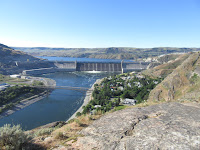We were surprised to find a national historic site managed
by the National Park Service in Walla Walla Washington. At Whitman Mission NHS we
learned about a missionary family who predated the flow of pioneers into
northern Oregon by over 5 years!
In 1835, the American Board of Foreign Missions sent Dr.
Marcus Whitman and his wife Narcissa to the Oregon Country to select a mission
site. Their mission was to convert the indigenous folk to Christianity and
thereby, save them from eternal damnation. For over 5 years the Whitman’s only lived
among the Cayuse tribe preaching the bible. The only other white Europeans they
saw were trappers working for the Hudson’s Bay Company.
In 1841 American pioneers began to arrive from the east. Only
25 documented pioneers entered Oregon in 1841, 100 in 1842 and 800 in 1843. It
wasn’t until the late 1840’s that the numbers became thousands per year. With
those large numbers came the diseases that the white Europeans had built
resistance to – small pox and others. The Cayuse saw that when whites
contracted diseases, Dr. Whitman was able to cure them. But when the Cayuse
contracted these diseases, they died.
In 1847 a particularly vicious strain of measles hit the
area. Again, whites generally survived when treated by Dr. Whitman, but upwards
of half the entire population of Cayuse died from this epidemic. Believing that
Dr. Whitman was either not treating them the same as whites, or may even be poisoning
them, on November 29 1847, a Cayuse party attacked the Mission killing the
Whitman’s and 10 other pioneers who had holed up there for the winter.
The NHS is the site of the 1835 Mission. The original grave
site where the Whitman’s and other pioneers killed in the massacre is on a hill
overlooking the Mission site. No buildings are here, but the foundations of the
original Mission buildings have been excavated so you can see and actually
stand in the rooms where both Marcus and Narcissa Whitman’s dead bodies lay
after the raid.
This was a very interesting site, and not one either of us
had learned about in school.
We also visited the Frenchtown Historic Site. In the late
1840 with the arrival of thousands of pioneers, towns started to dot the Walla
Walla River. This site was a town established primarily by French Canadians,
and also ended up being the location of the Battle of Walla Walla, the longest
battle with natives in the Oregon territory. This cabin was actually built in
1837, and is the oldest standing structure in the state.
Talk to you soon!
 It seems like all kinds of folks consider themselves
comedians. But many have no real outlet for what they consider their talent.
Along our many travels and wanderings, we have uncovered such comedians
attempting to scratch their itch using signs.
It seems like all kinds of folks consider themselves
comedians. But many have no real outlet for what they consider their talent.
Along our many travels and wanderings, we have uncovered such comedians
attempting to scratch their itch using signs. I have no doubt that every city in every town – not just in
America but all over the world – has at least one of these roadways, if not
officially, then at least by reputation. I can only imagine how many of these
are in Washington DC.
I have no doubt that every city in every town – not just in
America but all over the world – has at least one of these roadways, if not
officially, then at least by reputation. I can only imagine how many of these
are in Washington DC. Probably the topic you see addressed over and over and over in
RV Parks is folk who refuse to clean up after their pets. Most of the time it
is just
Probably the topic you see addressed over and over and over in
RV Parks is folk who refuse to clean up after their pets. Most of the time it
is just 








































